1970s in fashion
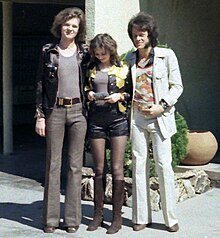

Fashion in the 1970s was about individuality. In the early 1970s, Vogue proclaimed "There are no rules in the fashion game now"[1] due to overproduction flooding the market with cheap synthetic clothing. Common items included mini skirts, bell-bottoms popularized by hippies, vintage clothing from the 1950s and earlier, and the androgynous glam rock and disco styles that introduced platform shoes, bright colors, glitter, and satin.[2]
New technologies brought advances in production through mass production, higher efficiency, generating higher standards and uniformity. Generally the most famous silhouette of the mid and late 1970s for both genders was that of tight on top and loose on bottom. The 1970s also saw the birth of the indifferent, anti-conformist casual chic approach to fashion, which consisted of sweaters, T-shirts, jeans and sneakers. The French designer Yves Saint Laurent and the American designer Halston both observed and embraced the changes that were happening in the society, especially the huge growth of women's rights and the youth counterculture. They successfully adapted their design aesthetics to accommodate the changes that the market was aiming for.
Top fashion models in the 1970s were Lauren Hutton, Margaux Hemingway, Beverly Johnson, Gia Carangi, Janice Dickinson, Cheryl Tiegs, Jerry Hall, and Iman.
Women[]
Early 1970s (1970–73)[]
Hippie Look[]
- The 1970s began with a continuation of the hippie look from the 1960s, giving a distinct ethnic flavor. Popular early 1970s fashions for women included Tie dye shirts, Mexican 'peasant' blouses,[3] folk-embroidered Hungarian blouses, ponchos, capes,[4] and military surplus clothing.[5] Bottom attire for women during this time included bell-bottoms, gauchos,[4][6] frayed jeans, midi skirts, and ankle-length maxi dresses. Hippie clothing during this time was made in extremely bright colors,[7] as well as Indian patterns, Native American patterns, and floral patterns.[8]
- Women's hippie accessories of the early 1970s included chokers, dog collars, handcrafted neck ornaments, and accessories made from natural elements like wood, shells, stones, feathers, Indian beads and leather. All of these replaced standard jewelry.[4] Unisex hippie accessories included headbands, floppy hats, balumba balls, flowing scarves,[5] Birkenstocks,[9] and earth shoes.[10]
Glamour[]

- Although the hippie look was widespread, it was not adopted by everyone. Many women still continued to dress up with more glamorous clothes, inspired by 1940s movie star glamour. Other women just adopted simple casual fashions, or combined new garments with carefully chosen secondhand or vintage clothing from the 1930s, 1950s and 1960s.[11] More simple early 1970s trends for women included fitted blazers (coming in a multitude of fabrics along with wide lapels), long and short dresses, mini skirts, maxi evening gowns, hot pants (extremely brief, tight-fitting shorts) paired with skin-tight T-shirts,[7] his & hers outfits (matching outfits that were nearly identical to each other), and flared pants. Pastel colors were most commonly used for this style of clothing, such as mauve, peach, apple green, pink, yellow, white, wheat, camel, gray, and baby blue.[4] Rust, tangerine, copper, forest green, and pistachio became more popularized from 1973 onwards.[4] Sweaters were a huge phenomenon in the early 1970s, often outfits being judged entirely by the sweater. This fragmented into more styles, such as sweater coats, sweater dresses, floor-length sweaters, and even sweater suits. Many of them were trimmed with fur, especially faux. Chunky, shawl-collared, belted cardigans, often in brown and white, were also commonplace.[4]
- Glamorous women's accessories of the early 1970s included cloche hats or turbans, pearl earrings, necklaces, bracelets, feather boas, black-veiled hats, clogs, wedgies, cork-soled platforms, and chunky high heels.[4] Golden chains, gold-button earrings and rhinestone clips started to become popular again in 1973 after several years of homemade jewelry.[4][12]
- In the early 1970s boots were at the height of their popularity, continuing onward from the mid 1960s. Women had boots for every occasion, with a wide variety of styles being sold in stores for affordable prices. Despite the wide variety, the most popular boots were Go-go boots, crinkle boots (boots with a shiny wet look that was wrinkled), stretch boots, and granny boots (1920s style lace-up boots that ended just below the knees).[13]
Mid 1970s (1974–76)[]

Casual looks[]
- By 1974, the T-shirt was no longer considered underwear, and was by then made in elaborate designs such as slogans, sports teams, and other styles.[4] Around the same time the looser, more flowy shirts of the early 1970s had given way to fitted tops.
- By the mid-1970s, the hippie look had completely disappeared, although casual looks continued. In the mid-1970s women wore sweaters, T-shirts, cardigans, kimono, graphic T-shirts and sweaters,[7] jeans, khakis, gauchos,[6] workmen's clothes, and vintage clothing.[4] Around 1976, casual fashion adopted a Parisan peasant look. This included capes, turbans, puffy skirts and shirts with billowing sleeves.[4]
- In the mid-1970s, accessories were generally not worn, adopting a minimalistic approach to fashion akin to that of the 1950s. Small leather shoulder bags were worn by women everywhere, and popular shoes included Mary Janes, knee-high boots with rounded toes, platform shoes and sandals, Birkenstocks,[9] and loafers.[4][7] Despite the lack of accessories, the mood ring was a big fad in the mid-1970s.[14]
Active wear[]
- Clean-cut, all-American active wear for women became increasingly popular from 1975 onwards. The biggest phenomenon of this trend was the jumpsuit, popular from 1975 onwards. Jumpsuits were almost always flared in the legs, and sleeves varied from being completely sleeveless to having extremely long bell-sleeves.[4] Other sportswear trends included tracksuits, tunic shirts, crop tops, tube tops, sweatshirts, hip-huggers,[15] low rise pants, and leisure suits.[4][7] This continued into the 1980s.
- Accessories were less of an importance during this time, but two very desirable accessories included sneakers and tennis headbands.[7][15]
Tailored styles[]
- As the divorce rate rose and the marriage rate declined in the mid-70s, women were forced to work in order to support the nuclear family. The progressive addition of women to the work force altered shopping styles and fashion. Working women shopped on weekends and in the evenings. Feminized men's business suits such as tailored jackets, midi-skirts, and fitted blouses were their go-to choice as to "dress for success."[16]
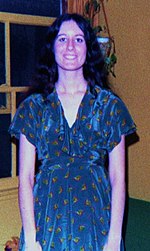
- Starting in 1975, women's semi-formal wear became more tailored and sharp. This included a lot of layering, with women wearing two blouses at once, multiple sweaters, pants underneath tunic dresses, and jumpers worn over long, fitted dresses. The 1970s also featured some of the most scandalous dresses worn publicly in American history up to that point.[7] Other clothes worn in this style include suede coats, peacoats, blazers, cowl-neck sweaters, pencil skirts, backless dresses, extremely low-cut dresses, palazzo pants,[7] tube dresses,[4] evening gowns, jacket dresses,[8] and pinstriped pantsuits.[4][7] Women's dresses in the mid-1970s were dominated by pastel colors, but Asian patterns were also common.[8]
- Accessories for the more formal styles included high-heels (both low and high, mostly thick-heeled), turbans, and leather shoulder bags.[7] Boots continued their popularity in the mid-1970s. This trend expanded to other styles, most notably the wedge heel (arguably the most popular women's shoe of the mid-1970s). Boots became rounder, chunkier, heavier, and thicker, and were more expensive than they were in the early 1970s. Popular boots of the mid-1970s included wedge boots, ankle boots, platform boots, and cowboy boots.[13] The A/W Haute Couture Collection "Opium Collection" by the French designer Yves Saint Laurent was inspired by the Chinese culture and history.
Disco look[]

- The disco music genre spawned its own fashion craze in the mid- to late 1970s. Young people gathered in nightclubs dressed in new disco clothing that was designed to show off the body and shine under dance-floor lights. Disco fashion featured fancy clothes made from man-made materials. The most famous disco look for women was the jersey wrap dress, a knee-length dress with a cinched waist. It became an extremely popular item, as it flattered a number of different body types and sizes, and could be worn both to the office by day, and to nightclubs and discos by night.[17]
- Disco fashion was generally inspired by clothing from the early 1960s. Disco clothes worn by women included tube tops, sequined halterneck shirts, blazers, spandex short shorts, loose pants, form-fitting spandex pants, maxi skirts and dresses with long thigh slits, jersey wrap dresses, ball gowns, and evening gowns.[8] Shoes ranged from knee-high boots to kitten heels, but the most commonly worn shoes were ones that had thick heels and were often made with transparent plastic.
Late 1970s (1977–79)[]
Relaxed look[]
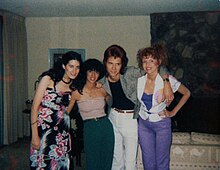
- In 1977, fashion became more baggy. This caused much controversy, as women with trim figures bemoaned not being able to flaunt them while heavier women complained the looser clothes made them look even larger. To make up for this, it became fashionable to show more skin. This resulted in shirts being unbuttoned, sleeves being rolled up, and tops being strapless, transparent, and lacy. Shiny satin and gold colors were also used to make up for the lack of tighter clothing. Styles became curvier in 1978, with shoulder pads, tighter skirts, and narrower waistlines. The silhouette that resulted was an inverted triangle, it was positively received by the general public.[4] By 1977, pants were only flared slightly and sometimes not flared at all.[7]
- Women's fashions in the late 1970s included cowl-neck shirts and sweaters, pantsuits, leisure suits, tracksuits,[4] sundresses worn with tight T-shirts,[3] strapless tops, lower-cut shirts, cardigans,[7] velour shirts, tunics, robes, crop tops, tube tops, embroidered vests and jeans, knee-length skirts,[8] loose satin pants,[4] designer jeans,[18] culottes, daisy dukes, and tennis shorts.[7] This continued into the 1980s.
- Accessories included scarves, gold jewelry, flowers, ankle boots, 1940s style hats (often tilted), skinny and wide belts, boas, braceleted gloves, spike-heeled sandals, mules, ankle-strapped shoes, waist cinchers, and obi wraps. Color had almost completely faded from fashion in the late 1970s, with earthy tones like browns, light blues, tans, grays, whites, and blacks making a comeback.[4][7]
- The frenzy for boots had cooled down by the late 1970s, but they remained popular, especially in the winter. They became less flamboyant by that point in time, and they mostly came in black, brown, or burgundy. The most popular boots were either knee-high or reached the mid-calf, and were made in leather, suede, urethane, or rubber. The toes were rounded, and zippers were on the side. The heels were usually only 2–4 inches, and the heels were sometimes even flat. Women continued to wear wedge heels and ankle boots, as well as knee-high boots with thick kitten heels.[13]
- In Pakistan, Afghanistan and Iran, many liberal women wore short skirts,[19][20] flower printed hippie dresses, flared trousers,[21] and went out in public without the hijab. This changed following the military dictatorship in Pakistan, the mujahideen government in Afghanistan, and Iranian revolution of 1979, when traditional conservative attire including the abaya, jilbab and niqab made a comeback.[22][23][24]
One-piece swimsuits[]
- In 1977, American actress Farrah Fawcett popularized the one-piece swimsuit which in turn launched the trend for the maillot. This was, when it resurged in the 1970s, a sexy, tight swimsuit, with deep neckline and high-cut legs, worn by young women and girls in lieu of the bikini, although it did not entirely replace the latter. This continued into the 1980s.
The Pantsuit[]
- By the late 1970s the pantsuit had become acceptable business wear for executive women. This was due to the success of Yves Saint Laurent's "Le smoking" tuxedo with silk lapels designed to allow any ash falling from cigarettes to slide off, keeping the jacket clean.[25] Business Insider pointed out that wearing the pantsuit was more of a political statement than a fashion one. "So, dressing in a YSL trouser suit declared the wearer was irreverent, daring, and on the cutting edge of fashion, whilst suggesting their alignment with burgeoning feminist politics – le smoking effectively demanded: 'If men can wear this, why can't I?'" With the increase of women entering the workface, they were in search for a new symbol that proved they were as serious and powerful as the men they shared elevators with. The only solution to convince male-dominated workspaces was to copy their tailored suits. The jacket could be either short and shapely or long and lean.
- Movies like Annie Hall fought gender ideals by portraying a woman who wore men's clothing on the daily basis. This movie took a big inspiration from the decade and because of its success, continues to influence fashion. Skirts, when worn, were often knee-length and could possibly have a front or side slit that put a subtle emphasis on the legs. To offset the more traditionally masculine look of "business suit style", women like Margot Kidder in Superman experimented with hats, high heels, ruffles that peaked out from the jacket and large jewelry to keep a confident, yet feminine, look intact.[26]
Men[]
Early 1970s (1970–73)[]

Peacock revolution[]
- With well-paid jobs and booming businesses, young men in the UK and America explored beyond the conventional social standards of dress. In the early 1970s, satin shirts in black, and grey were popular, and often featured lace ruffles on the cuffs and neckline. Due to the colorful nature of menswear, the time period was described as the Peacock Revolution, and male trendsetters were called "Dandies", "Dudes" or "Peacocks".[27] Typical casual wear for this time included Nehru jackets, ethnic inspired tunics, turtlenecks, candy striped blazers,[28] winklepicker boots with Cuban heels, and hip-hugging elephant bell-bottoms.[29] Accessories like color-matching nylon zippers and bright braided belts were common and also fitted in with the Peacock style.[30] Suits were available in bright colors and unorthodox styles from 1970–76, including shawl collars, three pieces with peak lapels, and double breasted suits made from corduroy, paisley brocade, wool blends with wide pinstripes, or crushed velvet in burgundy, teal, black, bottle green, and peacock blue. A rise of 4.4 percent in suit sales was reported by Forbes Magazine. Stylish continental suits by designers Lanvin, Yves Saint Laurent and Pierre Cardin were welcomed by young men while classic suits were loved by first-timers.[31]
Bright colors[]
- For the first time in decades, there was a significant shortage of raw materials and fabrics, including synthetics like vinyl and nylon. As a result, everyday designers kept things simple.[4] The early 1970s were a continuation of late 1960s hippie fashion. For men this particularly meant bell bottom jeans, tie dye shirts, and military surplus clothing.[5] Other early 1970s clothes for men included tweed sports jackets, khaki chinos, chunky sweaters in cream, dark green, beige and sky blue, storm coats, tartan jackets, peacoats, flannel shirts, pleated pants, baseball jackets,[4] corduroy pants, crocheted waistcoats, striped pullover sweaters and sweater vests, tassels, belted cardigans,[32] and hip-huggers.[15]
- The most popular accessories of the early 1970s for men were homemade, with necklaces, headbands, and bracelets being made from all-natural materials such as wood, hemp, flowers, leather, shells, stones, and Indian beads.[4] Unisex hippie accessories included headbands, floppy hats, and flowing scarves.[5] Men's footwear in the early 1970s included flip-flops, oxfords, Birkenstocks,[9] platform shoes, earth shoes,[10] and cowboy boots.[32]
Eastern fashion[]

- Due to the ongoing Cultural Revolution in Mainland China, Western style clothing was suppressed and both sexes wore grey Mao suits until the early 1980s.[33] The suit, unchanged since the 1940s, typically had four external pockets, five buttons, and a turn-down collar.[34] In contrast to the Chinese mainland, many people in Taiwan and Hong Kong abandoned the Zhongshan suit during the early 1970s due to its association with Communism and anti-Westerners.[35]
- In the UK, France,[36] India[37] and Australia,[38] green, blue or beige safari jackets similar to the Mao suit became popular among liberal men due to their association with socialist values, travel to exotic locations, 1930s Hollywood, and Roger Moore's portrayal of James Bond and Simon Templar.[39] These were also worn in place of the business suit in decolonised African countries, including South Africa, Rhodesia, and Mobutu's Zaire where it was known as an Abacost[40] and paired with a leopardskin fez resembling an Astrakhan cap.[41]
Mid 1970s (1974–76)[]
Glam rock[]
- By 1974, androgynous glam rock fashion had gone mainstream for young British[42] people of both sexes. These included embroidered Western shirts, velvet sports coats, Royal Stewart tartan as worn by the Bay City Rollers, red or blue shawl collar tuxedo jackets, frilly shirts, high necked nehru jackets, synthetic fabrics like satin, wide kipper ties, black or tan leather jackets, silk scarfs or ascots, shawl collar sweaters, satin shirts with oversized collars, drainpipe trousers as worn by Mud, and platform shoes of the type favored by Slade, Kiss, Alvin Stardust, David Bowie, and Sweet.[43][44] Unisex men's and women's outfits with few differences often came together in matching sets, and popular colors included cream, burgundy, brown, and orange.[4]
Informal attire[]
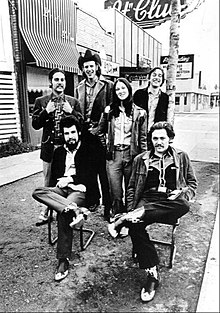
- Fashion in the mid-1970s was generally informal and laid back for men in America. Most men simply wore jeans, sweaters, and T-shirts, which by then were being made with more elaborate designs. Men continued to wear flannel, and the leisure suit became increasingly popular from 1975 onwards, often worn with gold medallions and oxford shoes. Vintage clothing, khaki chinos, workmen's clothes, sweatshirts, leather coats, and all-denim outfits were also desired among young men.[4] Other trends include printed shirts, zip-up cardigans, western shirts marketed to capitalise on the nostalgia for 1950s fashion, Birkenstocks,[9] mood rings,[14] and raincoats.[32]
- Around 1975, American suits started to resemble the slimmer European suit. This new model, named the quasi-European suit, featured padded shoulders, higher arm holes, a smaller waist, open patch pockets, and a small flare to the pants and jacket.[4] In 1976, it became fashionable for men to wear velvet tuxedo jackets with more casual pants to formal events, and vests came back into vogue. It was this year that men's pants started to feature smaller flares or no flares at all.[4] This continued into the 1980s.
- In Brezhnev's Russia, used Western clothing, especially sheepskin coats and flared trousers, became readily available due to the détente.[45] Previously, jeans had to be imported on the black market.[46] Politburo members continued to wear the black, grey or brown suits and fur lined overcoats of the 1960s, with grey Astrakhan caps.[47]
Late 1970s (1977–79)[]
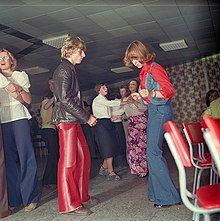
Sportswear[]
- By the late 1970s, most men and women were wearing sports clothing as everyday apparel. This was primarily based on tracksuits, jumpsuits, velour or terry cloth shirts (often striped and low-cut),[4] sweaters, cardigans, sweatshirts, puffer vests,[32] flare jeans,[4] straight-leg jeans, and collared shirts, both long sleeve and short sleeve. Around this time it also became fashionable for men to leave their shirts untucked.[32] This continued into the 1980s. During the late '70s, long and popped collars became a staple part of men's fashion.
- Late 1970s accessories included low-top sneakers, tennis headbands,[32] puka shell necklaces, and wristbands.
Disco style[]
- From 1977–79, menswear became affected by the disco style. Men began to wear three-piece suits (which became available in a variety of colours including powder blue, beige, white as worn by John Travolta in Saturday Night Fever, brown polyester, and shiny silver sharkskin) which were characterized by wide lapels, wide-legged or flared trousers, and high-rise waistcoats (US vests).[48] Influenced by the popularity of aviator sunglasses in disco, many wore glasses in the shape of aviators but with clear prescription lenses.[49] Neckties became wider and bolder, and shirt collars became long and pointed.[50]
Teenage fashion[]
Mods[]
- During the early 1970s, the Northern soul and suedehead subcultures emerged in response to the psychedelic rock, Bohemian and hippie influences on the mainstream peacock mod subculture. Seeking a return to the music and fashions of the mid and late 1960s, members of these British subcultures wore Ben Sherman shirts, slim fit pants, tank top sweaters, vintage striped boating blazers, basket weave brogue shoes, black leather driving gloves, pork pie hats, Irish walking hats, and loose fitting Oxford bags for dancing.[51] Secondhand mod clothing was also worn by many early garage punk and protopunk bands from the mid-1970s onwards, especially the Flamin Groovies and Television due to its cheapness and wide availability. The release of the cult film Quadrophenia in 1978 sparked a large scale Mod revival among a younger generation of Lambretta and Vespa scooter enthusiasts influenced by punk rock and new wave music.[52]
Teddy boys[]

- Due to a resurgence in nostalgia for the 1950s, the Teddy boy subculture made a comeback in the UK during the early 1970s. A similar rockabilly subculture known as Raggare underwent a revival in Sweden and Germany at the same time. Brothel creepers, drainpipe trousers, bolo ties and drape jackets were popular, typically with contrasting velvet collars and cuffs.[53] Influenced by glam rock bands like Showaddywaddy, the Teds of the 1970s wore bright colors like electric blue, leopardskin or brocade waistcoats, and styled their hair with hair spray rather than brylcreem.[54] In the late 1970s the Teds became the arch enemies of the punk subculture and Mod revivalists.
Hippies[]

- One of the most ubiquitous subcultures of the early and mid 1970s were the hippies. Typically middle class youths from Britain, America and New Zealand, these practitioners of free love favored a unisex look with long hair, tie dye and flower power motifs, Bob Dylan caps, kurtas, hemp waistcoats, baja jackets, bell bottoms, sandals, and maxi skirts for the girls.[55] Due to the United States' active involvement in the Vietnam War from 1954 to 1975, American teenagers wanted to make an antiwar counterculture statement through the way they dressed. Old military uniforms and washed off navy bell-bottoms were commonly purchased from secondhand stores, and then embellished with floral embroideries and brightly colored peace symbol patches at home.[56] In reaction to the conservative ivy league fashions favored by their parents, American hippies of both sexes rejected designer brands in favor of a unisex style, often making use of corduroy, hemp, and vintage clothing from charity shops.[57] Although glam rock had largely supplanted the hippie movement in urban areas during the mid to late 70s, offshoots such as the New Age travellers, Freak scene, Nambassa housetruckers[58] and surfers continued until the 1990s.
Heavy metal[]
- During the early and mid 1970s members of the hard rock and heavy metal subculture favored typical hippie fashions like earth tones, tie dye T-shirts, and flared trousers of the type worn on stage by Jethro Tull or Led Zeppelin. This changed later in the decade, when many fans of Judas Priest, AC/DC and Meat Loaf began imitating the clothing of greasers, outlaw bikers, punk rockers and leathermen due to the association of such fashions with toughness.[59] Typical heavy metal fashions in the UK, US and Australia included faded jeans, leather battle jackets, combat boots, studded belts, black leather jackets[60] like the Schott Perfecto, and iron crosses frequently pilfered from their father's war souvenirs. Beards, moustaches and shoulder length hair were popular among men, while female metal fans sometimes imitated the brightly dyed, teased and backcombed punk hair of the late 1970s.
Black power[]
- Urban African American youths frequently imitated the paramilitary uniforms of the Fruit of Islam, anti-colonialist African insurgents, and early 1970s black power groups like the Black Panthers.[61][62] The Panthers' French counterparts called themselves the Del Vikings and Black Dragons, listened to rockabilly and punk rock, and fought against neonazi skinheads during the late 70s and early 80s.[63]
- Typical clothing included black leather jackets, vests, black driving gloves,[64] leather peaked caps embellished with chains and metal studs, African folk costume like the fez or dashiki, traditional African colors like black, red, yellow or green, Ancient Egyptian jewelry such as the Ankh, gold chains, and railroad stripe pants for women.[65] Due to the poverty in the ghetto, black children often wore secondhand clothing that was too big or too small, inspiring the baggy pants worn as hip-hop fashion during the 1980s and 1990s. In the UK, US and Jamaica Afro hair[66] and dreadlocks became popular from 1972–1976 among Motown, soul music and reggae fans of both sexes, as a rejection of the straightened hairstyles associated with white culture.[67]
Cholos[]
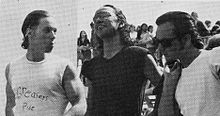
- Following the recession of 1973, the zoot suited pachuco look declined due to its association with comedic Blaxploitation pimps.[68] Instead, working class Mexican youths began dressing in a more casual style inspired by the clothing of prison gangs, left wing counterculture groups like the Brown berets,[69] the antiwar movement,[70] and the 1960s greaser subculture. White T-shirts, winklepickers, double denim "Texan tuxedos," ringer Tees, plaid shirts, Aviators, black wool tuques, brown berets,[71] green military surplus field jackets, sheepskin coats, Castro hats, untucked white shirts,[72] and khaki Dickies pants were commonly worn by these cholos and chicanos, together with slicked-back pompadour hairstyles and large sideburns.
Punks[]
- Punk rock was a musical genre that greatly influenced fashions for both sexes in the late 1970s. A great deal of punk fashion from the 1970s was based on the designs of Vivienne Westwood and her partner Malcolm McLaren, McLaren opened a stall at the back of vintage American clothing store, which taken over 430 King's Road and called it 'Let it Rock'. By 1974, 430 had renamed the store, which became famous as 'SEX'. McLaren described SEX as 'a haven phenomenon known as punk rock.'[73] Punk emerged in London, and spread into the United States. A complex amalgam of various stylistic influences, Punk had its roots in the streets of London and the music scene of New York.[73] Street punk fashion generally consisted of ripped clothes, black turtlenecks, drainpipe jeans, tight leather pants, leather jackets (often embellished with chains, spikes, studs, and paint), jackets and shirts with taboo images or messages, dog collars, safety pins, kilts, and Doc Martens.[74] A tamer, less threatening version of the Punk style called "New Wave", which featured jagged hems on clothing and more elaborate embroidery went mainstream in the early 1980s.[75]
1970s beauty trends[]
Women's hairstyles[]
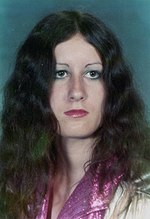
Throughout much of the decade, women and teenage girls wore their hair long, with a centre or side parting, which was a style carried over from the late 1960s. Other hairstyles of the early to mid-1970s included the wavy "gypsy" cut, the layered shag, and the "flicked" style, popularly referred to as "wings", in which the hair was flicked into resembling small wings at the temples. This look was popularised by the stars of the television series Charlie's Angels. Blonde-streaked or "frosted" hair was also popular. In 1977, punk singer Debbie Harry of Blondie sparked a new trend with her shoulder-length, dyed platinum blonde hair worn with a long fringe (bangs).
In the 1970s, making one of the popular hairstyles for a woman didn't take a lot of time. These hairstyles, including Afro hairstyle, Shaggy Hairdo and Feathered hair (then known as "Farrah Fawcett hairstyle") were said to be perfect when you're on-the-go and would still keep your expressive style in-check.[76] For Black People in the United States and elsewhere, the afro was worn by both sexes throughout the decade. It was occasionally sported by Whites, especially Jewish Americans[77] as an alternative to the uniform long, straight hair which was a fashion mainstay until the arrival of punk and the "disco look" when hair became shorter and centre partings were no longer the mode.
The most iconic women's hairstyle of the 1970s is arguably the Farrah Fawcett hairstyle. Popularized in 1976, the hairstyle was heavily imitated by many American women and girls. It incorporated waves, curls, and layers. The style mostly worn with bangs, but could also be worn with a side part. To make it even more stylish, women and girls would frost their hair with blonde streaks.[78]
Men's hairstyles[]
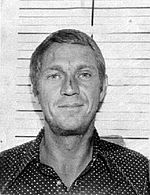
Continuing on from the 1960s, the ducktail and Pompadour hairstyle (then known as the "Elvis Presley hairstyle") were popular among young Italian-American and Mexican-American men in big cities like New York. Large quantities of grease or brylcreem was normally used to keep the hair in place. The early and mid 1970s generally featured longer hair on men, as way of rebelling against the social norms of years past.[79] Sideburns were also worn around the same time. Some of the most popular hairstyles for men include "Long and Luscious" hairstyle, mod haircut, and the "buzzcut" hairstyle popularised by action heroes like Steve McQueen. In the late 1970s, men went for the chop, ranging from crew cuts, to buzz cuts, to a shag. This was mainly done for an athletic look, and sideburns and facial hair went out of style.
Makeup and cosmetics[]
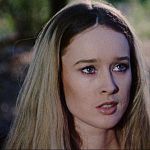
Cosmetics in the 1970s reflected the contradictory roles ascribed for the modern woman.[80] For the first time since 1900, make-up was chosen situationally, rather than in response to monolithic trends.[80] The era's two primary visions were the daytime "natural look" presented by American designers and Cosmopolitan magazine, and the evening aesthetic of sexualized glamour presented by European designers and fashion photographers.[80] In the periphery, punk and glam were also influential. The struggling cosmetics industry attempted to make a comeback, using new marketing and manufacturing practices.
Image gallery[]
Images representing the fashion trends of the 1970s.

The early 1970s' fashions were a continuation of the hippie look from the late 1960s.
Woman in miniskirt, 1970

A West German school girl with Schultüte in 1970, with a 'hippyish' outfit on.

In Kings Road, London, 1971, Swedish model Efva Attling wears a "midi" dress.

Fashion models in Leipzig, GDR, 1972. One of the girls is modelling a "maxi" dress.

Argentine fashion shoot for bell-bottoms in 1972.

Siouxsie Sioux of the English punk group Siouxsie and the Banshees. She personified the female punk look on both sides of the Atlantic.

David Bowie in the early 1970s. His avant-garde style of dressing exerted a strong influence on fashion in the first half of the decade.

American First Lady Pat Nixon wears a shirt with the wide collar that was popular until the final years of the decade.

Girl in 1973 with a "flicked" hairstyle.

Los Angeles high school students, 1973. The tousled, blond surfer hair was popular for young men in southern California.

Singer Billy Preston in 1974 wearing an Afro hairstyle.

American casual attire, 1974.

British girls in 1975 in flared jeans

British singer Rod Stewart, 1976.

English girl in the mid-1970s wearing a wide-sleeved shirt, belted at the waist.
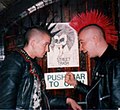
Two punks from the late 1970s

Debbie Harry of Blondie in 1977. A female punk icon, her dyed platinum blonde hair was widely copied by teenage girls and young women in Britain and America.

Susana Giménez wearing hotpants, 1977
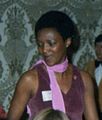
Silk scarves were popular fashion accessories for women in the 1970s.

Singer Barry Manilow wears his hair longish in the soft, layered style favoured by men in the 1970s.

Punk pioneer Lene Lovich in 1979, with her trademark long plaited hair.

Alan Bennett in 1973, wearing a wide necktie

Frisbee player Ken Westerfield wearing draw string bell bottoms in the 1970s
References[]
- ^ "1970's Revival – Fashion blog". Oxfam GB. Archived from the original on 24 September 2017. Retrieved 5 December 2017.
- ^ "Troubled Times: 1961–79". Retrieved 27 July 2014.
- ^ Jump up to: a b "Paperpast Yearbook". Paperpast.com. Archived from the original on 30 August 2017. Retrieved 5 December 2017.
- ^ Jump up to: a b c d e f g h i j k l m n o p q r s t u v w x y z aa ab ac "Fashion in the 1970s". Retrieved 1 July 2014.
- ^ Jump up to: a b c d "HIPPIES". Retrieved 3 July 2014.
- ^ Jump up to: a b "Gaucho Pants". Retrieved 3 July 2014.
- ^ Jump up to: a b c d e f g h i j k l m n "1970s Fashion for Women & Girls". Retrieved 2 July 2014.
- ^ Jump up to: a b c d e "1970s Dresses & Skirts: Styles, Trends & Pictures". Retrieved 2 July 2014.
- ^ Jump up to: a b c d "Birkenstocks". Retrieved 7 July 2014.
- ^ Jump up to: a b "Earth Shoes". Retrieved 7 July 2014.
- ^ Buckley, Cheryl (1 October 2007). Designing Modern Britain. Reaktion Books. ISBN 9781861893222.
- ^ "70s fashion icons". Glamour. 2014. Archived from the original on 29 October 2014. Retrieved 28 October 2014.
- ^ Jump up to: a b c "1970s Boots for Women: Styles, Trends & Pictures". Retrieved 2 July 2014.
- ^ Jump up to: a b "Mood Rings". Retrieved 7 July 2014.
- ^ Jump up to: a b c "Hip Huggers". Retrieved 2 July 2014.
- ^ Peacock, John (2010). 20th-century fashion: the complete sourcebook. London: Thames & Hudson Ltd. p. 533. ISBN 978-0-500-20402-3.
- ^ Pendergast, Tom and Sarah (2004). Fashion, Costume and Culture. MI, USA: Thomson Gale. p. 933. ISBN 0-7876-5422-1.
- ^ "Designer Jeans". Retrieved 7 July 2014.
- ^ "This is how Iranian women dressed in the 1970s before the Iranian Revolution". Thevintagenews.com. 8 June 2016. Retrieved 5 December 2017.
- ^ "Afghanistan Style in The '20s Through '70s: Photographs Show A Lost, Fashionable Time". HuffPost. 10 October 2013. Retrieved 24 September 2018.
- ^ Paracha, Nadeem F. (4 December 2015). "Pakistan's contrary years (1971–1977): A cultural history of the Bhutto era". Dawn. Retrieved 5 December 2017.
- ^ "16 Images of Pakistan's Swinging 1970s – SHUGHAL". Shughal.com. 6 March 2017. Archived from the original on 9 October 2016. Retrieved 5 December 2017.
- ^ "Take a look at these amazing photos of Iran before the revolution". Business Insider UK. Retrieved 5 December 2017.
- ^ Sarkar, Monica (7 April 2015). "Unveiled: Afghan women past and present". CNN. Retrieved 24 September 2018.
- ^ "The Fascinating History of Women Wearing te". Allure. Retrieved 22 April 2018.
- ^ "1970s Fashion: Styles, Trends, Pictures & History". retrowaste.com. Retrieved 22 April 2018.
- ^ "The Peacock Revolution". The Peacock Revolution and the Beatles: British Men's Fashion from 1963–1973. Retrieved 7 October 2017.
- ^ "V&A · The peacock revolution: 1960s menswear". Victoria and Albert Museum. Retrieved 5 December 2017.
- ^ "Sixties Style Revolution: The Peacock Revolution". Hiras.com. Retrieved 5 December 2017.
- ^ Hill, Daniel (August 2015). "PEACOCK REVOLUTION LEGACY: AMERICAN MEN'S FASHION IN THE 1970S". Bloomsbury Fashion Central.[permanent dead link]
- ^ Cunningham, Patricia (2005). "10 Dressing for Success: The Re-Suiting of Corporate America in the 1970s". Twentieth-Century American Fashion. Dress, Body, Culture. doi:10.2752/9781847882837/tcaf0014. ISBN 9781847882837.
- ^ Jump up to: a b c d e f "1970s Fashion for Men & Boys". Retrieved 2 July 2014.
- ^ Montefiore, Clarissa Sebag. "From Red Guards to Bond villains: Why the Mao suit endures". Bbc.com. Retrieved 5 December 2017.
- ^ "Mao suit". Depts.washington.edu. Retrieved 5 December 2017.
- ^ "The Mao Suit". 24 April 2015. Retrieved 5 December 2017.
- ^ "Safari suit designer dies". The Courier-Mail. Retrieved 5 December 2017.
- ^ "Safari suit symbol of vanished modern India". The National. Abu Dhabi. Archived from the original on 16 December 2011. Retrieved 5 December 2017.
- ^ "The turbulent times of Don Dunstan, a revolutionary in hotpants". The Independent. 18 March 2008. Retrieved 5 December 2017.
- ^ "Safari Jacket – The Suits of James Bond". The Suits of James Bond. Retrieved 5 December 2017.
- ^ "Les Sapeurs: Bringing subversive style to the Eastern Congo – The World Weekly". Theworldweekly.com. Retrieved 5 December 2017.
- ^ "Mode : les nostalgiques des années 70 exhument l'Abacost – adiac-congo.com : toute l'actualité du Bassin du Congo". Adiac-congo.com. Retrieved 5 December 2017.
- ^ Auslander, Philip (5 December 2017). Performing Glam Rock: Gender and Theatricality in Popular Music. University of Michigan Press. ISBN 978-0472068685.
- ^ "1970s Fashion: The Moments That Defined Seventies Style". Marie Claire. 17 March 2017. Retrieved 5 December 2017.
- ^ "The Evolution of Glam Rock Fashion". Rebelsmarket.com. Retrieved 5 December 2017.
- ^ Chernyshova, Natalya (26 June 2013). Soviet Consumer Culture in the Brezhnev Era. Routledge. ISBN 9781135046279.
- ^ Rudevich, Alexéi (16 September 2014). "Worth going to prison for: Getting hold of jeans in the USSR". Rbth.com. Retrieved 5 December 2017.
- ^ "Vladivostok Conference 1974". Pages.ramapo.edu. Retrieved 5 December 2017.
- ^ "Saturday Night Fever". IMDb. 16 December 1977. Retrieved 5 December 2017.
- ^ Nast, Condé (26 July 2019). "Vogue's fashion encyclopaedia: The history of aviator sunglasses". Vogue India. Retrieved 9 August 2021.
- ^ Tierney, Tom (5 December 2017). Everyday Fashions of the 20th Century. Courier Corporation. ISBN 9780486995441.
- ^ [ Keith Rylatt and Phil Scott. Central 1179: The Story of Manchester's Twisted Wheel Club. BeeCool Publishing. 2001]
- ^ "Chris Hunt – Mod Revival". Chrishunt.biz. Retrieved 5 December 2017.
- ^ "Greased Quiffs and Flick Knives: Growing Up Teddy Boy in 1970s England". Vice.com. 2 February 2015. Retrieved 5 December 2017.
- ^ "The Edwardian Teddy Boy – Leeds Teddy Boys". Edwardianteddyboy.com. Archived from the original on 5 December 2017. Retrieved 5 December 2017.
- ^ "Photos of hippies". Sixtiespix.com. Archived from the original on 3 July 2016. Retrieved 5 December 2017.
- ^ "Troubled Times: 1961–79 – Fashion, Costume, and Culture: Clothing, Headwear, Body Decorations, and Footwear through the Ages". Fashionencyclopedia.com. Retrieved 7 October 2017.
- ^ "Bell-Bottoms facts, information, pictures | Encyclopedia.com articles about Bell-Bottoms". Encyclopedia.com. Retrieved 7 October 2017.
- ^ "::: Nambassa :::". Nambassa.com. Retrieved 5 December 2017.
- ^ Weinstein, Deena (5 August 2009). Heavy Metal: The Music And Its Culture. Da Capo Press. ISBN 9780786751037.
- ^ Phillips, William; Cogan, Brian (20 March 2009). Encyclopedia of Heavy Metal Music. ABC-CLIO. ISBN 9780313348013.
- ^ "Higher Bitesize History – Post-war race relations : Revision, Page4". BBC. Retrieved 5 December 2017.
- ^ "Black Power". Getty Images. Retrieved 5 December 2017.
- ^ "Black Dragons: The Black Punk Gang Who Fought Racism & Skinheads in 1980s France". Okayafrica.com. 10 August 2016. Retrieved 5 December 2017.
- ^ "In Search of African America: One Collector's Experience. An exhibit at the Herbert Hoover Presidential Museum". Hoover.archives.gov. Archived from the original on 13 November 2017. Retrieved 5 December 2017.
- ^ Company, Johnson Publishing (1 September 1969). "Ebony".
- ^ "Ebony". Johnson Publishing Company. 1 February 1973. p. 132.
- ^ "Jet". Johnson Publishing Company. 13 July 1972. p. 16. Retrieved 5 December 2017 – via Google Books.
- ^ Bruzzi, Stella (12 October 2012). Undressing Cinema: Clothing and identity in the movies. Routledge. ISBN 9781134770595.
- ^ Rodriguez, Marc Simon (13 November 2014). Rethinking the Chicano Movement. Routledge. ISBN 9781136175374.
- ^ "Chicano Movement of Washington State History Project". Depts.washington.edu. Retrieved 5 December 2017.
- ^ "Young Chicano Revolutionaries". Fightbacknews.org. Retrieved 5 December 2017.
- ^ "That '60s story: Chicanos y the Citizen – Tucson Citizen Morgue, Part 1 (2006–2009)". Tucsoncitizen.com. Retrieved 5 December 2017.
- ^ Jump up to: a b Wilcox, Claire. Vivienne Westwood: 34 years in fashion. V&A PUBLICATIONS. pp. 12–13.
- ^ "Doc Martens". Retrieved 27 July 2014.
- ^ "Punk". Retrieved 27 July 2014.
- ^ "1970s Hairstyles". Buzzle.com. 21 September 2011. Retrieved 28 July 2016.
- ^ Murray Chass, "Harvard's Hairy Five Makes Some Foes Bristle", The New York Times, 28 February 1971, pg. S4.
- ^ "Farrah Fawcett Look". Fashionenecyclopedia.com. Retrieved 26 July 2014.
- ^ "Long Hair for Men". Fashionenecyclopedia.com. Retrieved 26 July 2014.
- ^ Jump up to: a b c De Castelbajac, pp. 147–48.
External links[]
| Wikimedia Commons has media related to 1970s fashion. |
- 1970s Fashion History
- 20th Century Fashion History: 1970s
- Men's Fashion History from the 1970s
- It Came from the 1971 Sears Catalog
- Children's clothing from the 1970s Archived 13 February 2009 at the Wayback Machine
- "1970s – 20th Century Fashion Drawing and Illustration". Fashion, Jewellery & Accessories. Victoria and Albert Museum. Archived from the original on 8 January 2011. Retrieved 3 April 2011.
- Marshmallow Shoes
- 1970s fashion
























